Get Easy Health Digest™ in your inbox and don’t miss a thing when you subscribe today. Plus, get the free bonus report, Mother Nature’s Tips, Tricks and Remedies for Cholesterol, Blood Pressure & Blood Sugar as my way of saying welcome to the community!
Follow these 4 steps to banish neck pain and tension for good

Whether we slept on it wrong the night before or tweaked it playing with the kids… we’ve all experienced the frustration of neck pain. And the most frustrating part? No matter how many times — or for how long — we stretch our necks, it never seems to relieve the pain.
That’s because, alone, stretches don’t actually relieve neck pain in the long term.
Most of us were taught from an early age that “stretching” a muscle creates additional length within the said muscle, making it “stretchier” in a sense.
This “stretchiness” was meant to help decrease pain and prevent future injury. Sadly, this theory isn’t 100 percent accurate. Our muscles need something more to create lasting pain-free changes.
Muscles Only Do What They’re Told
Muscles are dumb! When a muscle is chronically tight, the nervous system is telling the body, “there’s something unstable happening and we need the muscle to contract and help out.”
However, when we attempt to stretch this tight muscle — without finding the root cause — we will temporarily find relief, only for the nervous system to send the same contraction signals as before.
That’s why it’s so important to find the root cause before mindlessly stretching our sore necks, which normally is actually weakness or instability.
In fact, a recent study found that strengthening our neck muscles may be a better option for addressing the root causes of neck pain.
At the 12-month follow-up visit, both neck pain and disability had decreased (while their range of motion increased) in both strength and endurance training groups compared with the control group.
If Stretching Isn’t the Answer, What Is?
The life of healthy, pain-free necks starts with our posture.
Slouching builds pressure in the neck muscles and around the head. As well, this poor posture pushes our heads forward into an unnatural position. For each inch your neck bends forward over the neutral position, you are creating an extra 10 lbs. of weight on your neck.
But, when we actively shift our shoulder blades down and back, raising our head to the proper position, we alleviate the extra pressure and can help get rid of neck pain. A great way to practice great posture while strengthening the neck muscles used is through isometric exercises.
This 2014 study, discovered that isometric exercises have proven effective in managing chronic neck pain.
Isometric exercises are contractions of a single muscle or muscle group. The muscle does not perceptibly change length during isometric exercises as the joint does not move.
Isometric exercises help joints and muscles remain healthy while building strength in a low-impact way.
Isometric Exercises to Relieve Neck Tension
Isometric exercises do not take a lot of exertion or skill to perform, but can effectively train specific muscles to work properly. Isometric exercises are suitable for anyone with limited workout space, current discomfort or pain, or anyone simply seeking a change in their usual fitness routine.
Since these movements boost strength in one body position, they can act as an alternative to a more complex workout regimen. The next time you feel the need to stretch it out, give these isometric posture correction exercises a try instead:
Multidirectional Neck Tension Melter
Sit or stand tall with your feet flat on the ground and upright posture.

Press your palm against your forehead, resisting with your neck muscles. Do not actually move your head and use about 50 percent of your full force.
Hold for 5 seconds. Relax.
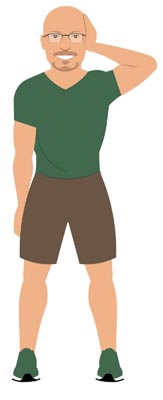
Do the exercise again, this time pressing on the left side of your head. Hold for 5 seconds. Switch sides.

Finally, do the exercise again, pressing on the back of your head. Hold for 5 seconds.
Repeat two more times for a total of 60 seconds.
While we may not be able to swivel our heads 360 degrees like an owl, our neck does allow us to move in some pretty far ranges of motion. However, these 4 planes of motion are often used disproportionately.
This causes one side of the neck muscles to be stronger than the others. By holding tension in several directions, we can begin to balance out our neck strengths and weaknesses.
Chin Tucks
Sit or stand upright and look straight ahead with the ears directly over the shoulders. Think of a string pulling from the base of your spine, through the crown of your head, and finally to the ceiling.
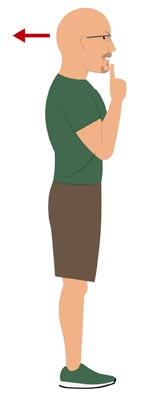
Place a finger on the chin. Without moving the finger, pull the chin and head straight back — as if another string is pulling the back of your head to the wall behind you — until a good stretch is felt at the base of the head and top of the neck. Hold for 5 seconds if possible.

Bring the chin forward again to meet the finger where you left it.
Repeat for a total of 5 times.
Forward head posture is a common problem felt by many today. This poor posture causes excess strain on the neck and spine that can easily be avoided by “resetting” to the correct head posture.
Chin Tucks allow us to strengthen the opposing muscles of the forward head position to help reset our head alignment and relieve any additional strain.
“W” Squeeze
Stand tall with your chin slightly tucked. Imagine that a string at the top of your head is pulling you straight up.
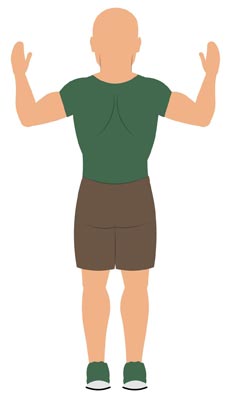
Raise your arms to each side, bending at the elbow. This should put your arms in a W-like position.
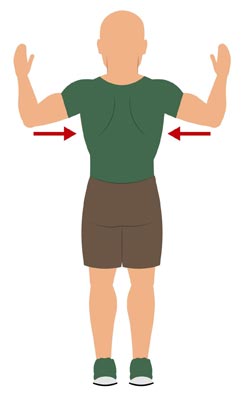
Pull your shoulder blades together and down — note that all motion will be coming for your shoulders while maintaining that slightly tucked chin position. Hold for 5 seconds.
Repeat 5 times.
Another common posture problem that causes neck pain is the rounding of our shoulders. By squeezing the shoulder blades down and back we can strengthen the supporting muscles for our neck.
When all our muscles are working properly, our neck is able to move and carry our head without any excess pressure or stress.
Chair Leans
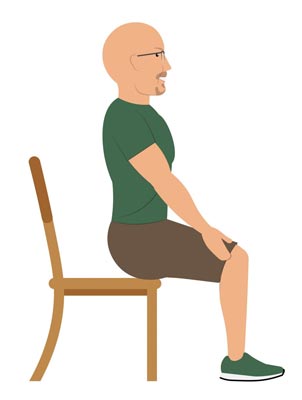
Sit on the edge of your chair. Inhale and sit up tall with your hands on the sides of your knees.
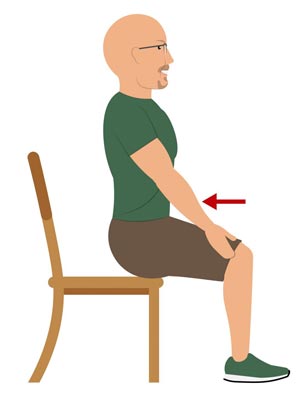
As you exhale, pull your belly button tight towards your spine.
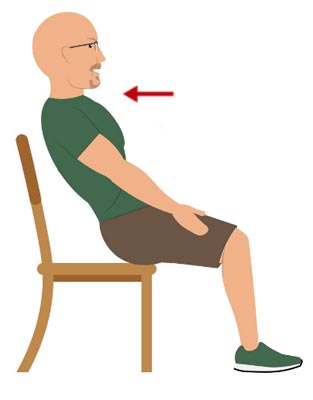
Begin to roll back while tucking your tailbone underneath you. You are trying to bring your shoulders to the back of the chair with control.
On your next inhale, keep your tummy tight and return to sitting.
Repeat 5 times.
Surprised to see a core exercise? Your neck doesn’t exist in isolation. The force exerted by the effective weight of the head is distributed all the way down along the spine. Therefore, any support given to the lower spine relieves pressure on the neck.
While stretching can provide some temporary relief, it’s important to understand the stretching alone won’t address the pain properly.
The above isometric exercises to relieve neck tension help to address common issues found in those who suffer from neck pain.













